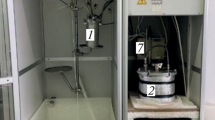Abstract
Polysulfone (PS) hollow-fiber ultrafiltration membrane was characterized combined with flux and streaming potential in single electrolyte solutions. The effects of trans-membrane pressure, electrolyte concentration, ion valence and pH value of electrolyte solution on the streaming potential (SP) of the membrane were investigated. The zeta potential and surface charge density of the membrane were calculated on the basis of Helmholtz-Smoluchowski equation and Gouy-Chapmann theory. The results indicate that the valence and concentration of cation have a greater influence on the SP and surface charge density of PS membrane than those of anion, and the pH value of electrolyte solution has great effects on the SP and zeta potential of the membrane surface. Both the absolute value of the streaming potential and water flux of the adsorbed membrane decrease, compared with those of the clean membrane. The streaming potential and flux of the cleaned membrane can be completely recovered by cleaning with the mass fraction of 0.8% EDTA at pH=10.
Similar content being viewed by others
References
STRAATSMA J, BARGEMAN G, HORST H C, WESSELINGH J A. Can nanofiltration be fully predicted by a model? [J]. J Membr Sci, 2002, 198(2): 273–284.
RICQ L, PIERRE A, REGGIAN J C, SERGE Z. Effects of protein on electrokinetic properties of inorganic membranes during ultra- and microfiltration [J]. J Membr Sci, 1996, 114(1): 27–38.
LEVINE S, MARRIOTT J R, NEALE G. Theory of electrokinetic flow in fine cylindrical capillaries at high zeta-potentials [J]. J Coll Interf Sci, 1975, 52(1): 136–149.
RICQ L, PAGETTI J. Inorganic membrane selectivity to ions in relation with streaming potential [J]. J Membr Sci, 1999, 155(1): 9–18.
ADAMCZYK Z, ZEMBALA M, MICHNA A. Polyelectrolyte adsorption layers studied by streaming potential and particle deposition [J]. Coll Interf Sci, 2006, 303(2): 353–364.
PONTIÉ M, DURAND-BOURLIER L, LEMORDANT D, LAINE J M. Control fouling and cleaning procedures of UF membranes by a streaming potential method [J]. Sep Purif Technol, 1998, 14(1): 1–11.
DOYEN W, ADRIANSENS W, MOLENBERGHS B, LEYSEN R. Comparison between polysulfone, zirconia and organo-mineral membranes for use in ultrafiltration [J]. J Membr Sci, 1996, 113(2): 247–258.
BENAVENTEA J, JONSSON G. Electrokinetic characterization of a microporous non-commercial polysulfone membrane: Phenomenological coefficients and transport parameters [J]. Coll Surf A: Physicochem Eng Asp, 1998, 140(1/3): 339–346.
BENEFIELD L D, JUDKINS J F, WEAND B L. Process chemistry for water and wastewater treatment [M]. Englewood Cliffs, New Jersey: Prentice-Hall Inc, 1982.
CHRISTOFOROU C C, WESTERMANN-CLARK G B, ANDERSON J L. The streaming potential and inadequacies of the Helmholtz equation [J]. J Coll Interf Sci, 1985,106(1): 1–11.
MORÃO A I C, ALVES A M B, AFONSO M D. Concentration of clavulanic acid broths: Influence of the membrane surface charge density on NF operation [J]. J Membr Sci, 2006, 281(1/2): 417–428.
DING Ning, WANG Xiao-lin, WANG Jian. Electrokinetic phenomena of a polyethylene microfiltration membrane in single salt solutions of NaCl, KCl, MgCl2, Na2SO4, and MgSO4 [J]. Desalination, 2006, 192(1/3): 18–24
ZHAO Yi-jian, XING Wei-hong, XU Nan-ping, WONG Fook-sin. Effects of inorganic electrolytes on zeta potentials of ceramic microfiltration membranes [J]. Sep Purif Technol, 2005, 42(2): 117–121.
MASKOOKI A, KOBAYASHI T, MORTAZAVI S A, MASKOOKI A. Effect of low frequencies and mixed wave of ultrasound and EDTA on flux recovery and cleaning of microfiltration membranes [J]. Sep Purif Technol, 2008, 59(1): 67–73.
Author information
Authors and Affiliations
Corresponding author
Additional information
Foundation item: Project(20776161) supported by the National Natural Science Foundation of China
Rights and permissions
About this article
Cite this article
Qiu, Yr., Miao, C. & Ye, Hq. Characterization of polysulfone hollow-fiber ultrafiltration membrane and its cleaning efficiency by streaming potential and flux method. J. Cent. South Univ. Technol. 16, 195–200 (2009). https://doi.org/10.1007/s11771-009-0033-3
Received:
Accepted:
Published:
Issue Date:
DOI: https://doi.org/10.1007/s11771-009-0033-3




